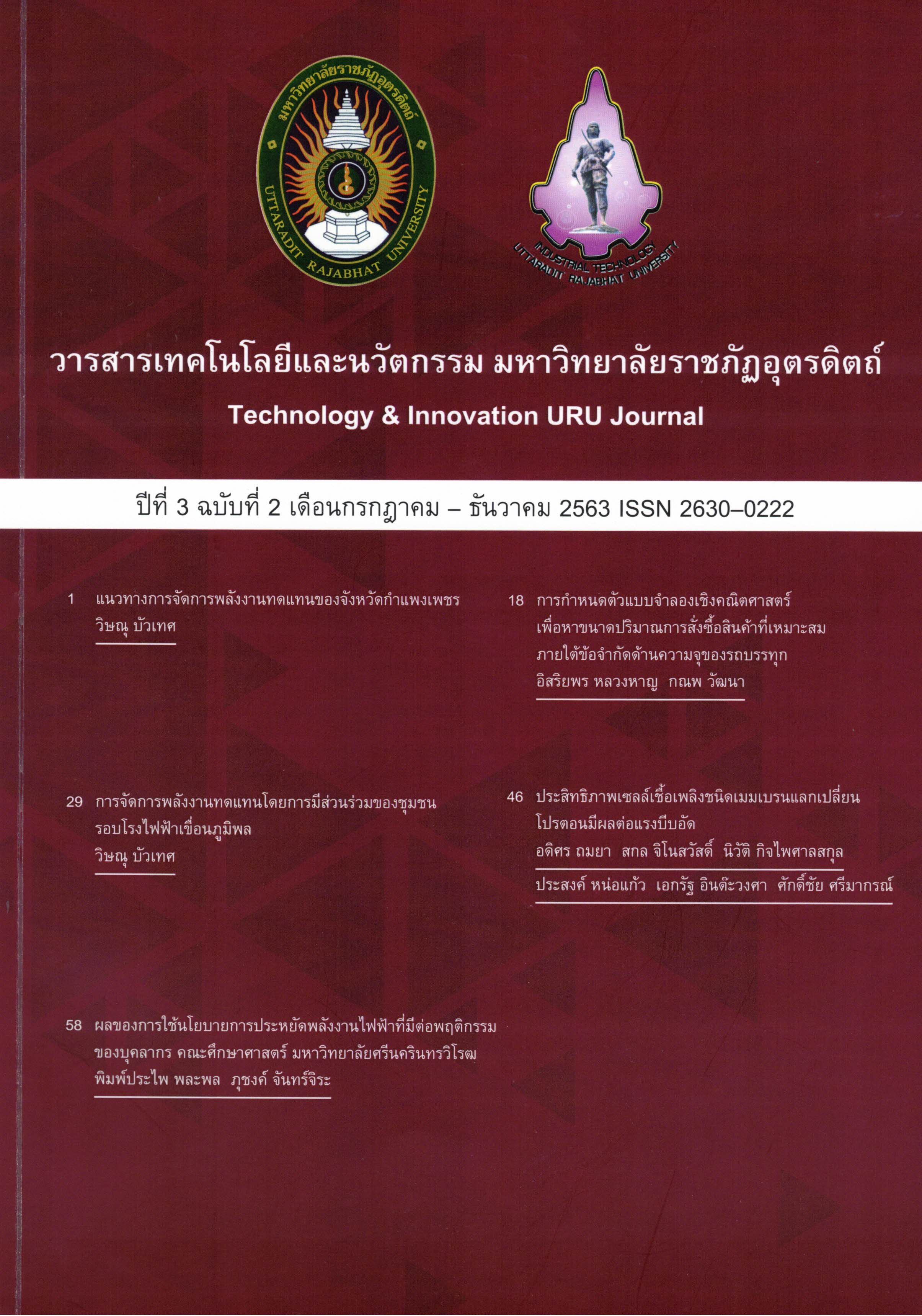Efficiency Proton Exchange Membrane Fuel Cell Affects Compression Force
Main Article Content
Abstract
Gas diffusion layer (GDL) is a major part, which affects proton exchange membrane fuel cell (PEMFC) performance. It can be role on electron conductivity and mass transport within fuel cell. This research was studied compression and porosity in diffusion layer for assembly PEMFC which they are independent to performance fuel cell. There was built assembly fuel cell machine for assembled fuel cell and compare performance with fuel cell assembled by compressed force from not. Gasket in this research made from Teflon of thickness 125, 175 and 225 microns, they had porosity in 0.16, 0.4 and 0.53, respectively. It was found relationship between porosity and thickness that decreased thickness was porosity decreased too.
This research used 10,000, 12,000, 14,000, 16,000 and 18,000 N/m2 in torque and flow rates were 200, 300 and 400 sccm. The results showed that the maximum efficiency of the fuel cell occurred at the 16,000 N/m2, flow rate of 300 sccm and porosity in 0.53 provided maximum power of 12.32 W at voltage of 0.44 and 28 A. The performance of the PEMFC from assembly fuel cell machine was compared with the PEMFC assembled by nut. The result of fuel cell from assembly fuel cell machine was similar to the fuel cell assembled by nut. However, fuel cell from assembly fuel cell machine delivered higher performance. It provided 4.8% higher than the fuel cell assembled by nut. Thus, assembly fuel cell machine can be used.
Article Details

This work is licensed under a Creative Commons Attribution-NonCommercial-NoDerivatives 4.0 International License.
References
ณัฐวุฒิ จารุวสุพันธุ์. (2548). การสร้างแบบจำลองเชิงตัวเลขของการไหลของก๊าซในเซลล์เชื้อเพลิง ชนิด พีอีเอ็ม. (ปริญญาวิศวกรรมศาสตรมหาบัณฑิต สาขาวิชาวิศวกรรมพลังงาน). เชียงใหม่: มหาวิทยาลัยเชียงใหม่.
ทรงวุฒิ นิรัญศิลป์. (2545). การออกแบบสร้างระบบทำความชื้นสำหรับเซลล์เชื้อเพลิงชนิดโพลิเมอร์อิเล็กโตรไลท์. (ปริญญาวิทยาศาสตรบัณฑิต สาขาฟิสิกส์). เชียงใหม่: มหาวิทยาลัยเชียงใหม่.
Austin, L. G. (1968). Hand book of Fuel Cell Technology, Englewood Cliffs, NJ: Prentice-Hall.
Barbir, F. (2005). PEM Fuel Cell: Theory and Practice. NY: Elsevier Academic Press.
Chang, W. R., Hwang, J. J., Weng, F. B., & Chan, S. H. (2007). Effect of clamping pressure on the performance of a PEM fuel cell. Journal of Power Sources, 166, 149–154
EG&E Services Parson, Inc. (2000). Fuel Cell Hand Book. West Verginia: Morganton.
Iwao, N. (2008). Inhomogeneous Compression of PEMFC Gas Diffusion Layers. (Doctoral Dissertation). Helsinki University of Technology, Finland.
Kiattamrong, S. & Sripakagorn, A. (2014). Effects of the Geometry of the Air Flowfield on the Performance of an Open-Cathode PEMFC. In Proceedings of 5th international Conference on Sustainable Energy and Environment (SEE2014) (pp. 408-413).
Kim, B., Lee, Y., Woo, A., & Kim, Y. (2013). Effects of cathode channel size and operating conditions on the performance of air-blowing PEMFCs. Applied Energy, 111, 441-448.
Kumar, P. M., & Kolar, A. K. (2010). Effect of cathode design on the performance of an air-breathing PEM fuel cell. International Journal of Hydrogen Energy, 35(2), 671-681.
MacDonald, C. S. (2009). Effect of Compressive Force on PEM Fuel Cell Performance. (Master’s thesis). Retrieved from https://uwspace.uwaterloo.ca/handle/10012/4252

